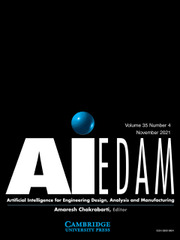No CrossRef data available.
Article contents
Internet of Things and hybrid models-based interpretation systems for surface roughness estimation
Published online by Cambridge University Press: 12 November 2024
Abstract
Face milling is performed on aluminum alloy A96061-T6 at diverse cutting parameters proposed by the design of experiments. Surface roughness is predicted by examining the effects of cutting parameters (CP), vibrations (Vib), and sound characteristics (SC). Sound characteristics based on surface roughness estimation determine the rarity of the work. In this study, a unique ANN-TLBO hybrid model (Artificial Neural Networks: Teaching Learning Based Algorithm) is created to predict the surface roughness from CP, Vib, and SC. To ascertain their correctness and efficacy in evaluating surface roughness, the performance of these models is evaluated. First off, the CP hybrid model demonstrated an amazing accuracy of 95.1%, demonstrating its capacity to offer trustworthy forecasts of surface roughness values. The Vib hybrid model, in addition, demonstrated a respectable accuracy of 85.4%. Although it was not as accurate as the CP model, it nevertheless showed promise in forecasting surface roughness. The SC-based hybrid model outperformed the other two models in terms of accuracy with a remarkable accuracy of 96.2%, making it the most trustworthy and efficient technique for assessing surface roughness in this investigation. An analysis of error percentages revealed the exceptional performance of SC-based Model-3, exhibiting an average error percentage of 3.77%. This outperformed Vib Model-2 (14.52%) and CP-based Model-1 (4.75%). The SC model is the best option, and given its outstanding accuracy, it may end up becoming the go-to technique for industrial applications needing accurate surface roughness measurement. The SC model’s exceptional performance highlights the importance of optimization strategies in improving the prediction capacities of ANN-based models, leading to significant advancements in the field of surface roughness assessment and related fields. An IoT platform is developed to link the model’s output with other systems. The system created eliminates the need for manual, physical surface roughness measurement and allows for the display of surface roughness data on the cloud and other platforms.
Keywords
- Type
- Research Article
- Information
- Copyright
- © The Author(s), 2024. Published by Cambridge University Press
Footnotes
This article was originally published with an incorrect affiliation for one author. The error has been corrected and the online HTML and PDF versions updated.
References
A correction has been issued for this article:
Linked content
Please note a has been issued for this article.


